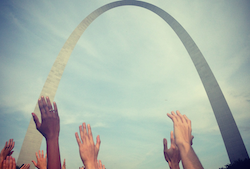For months, the image stayed in her phone. Laura Schatzman didn’t know what to do with it, but she knew it was special — a crowd of hands reaching toward blue sky, framed by St. Louis’ Gateway Arch.
She saw it, got chills, and it stayed in her phone.
Schatzman, a landscape and urban designer, went to a prayer and service event at Central Reform Congregation the night after the grand jury ruled not to indict police officer Darren Wilson in the death of Mike Brown. They prayed and made goodie bags for kids at Ferguson’s library, and Schatzman met a professional photographer.
“I’ve had this buried deep for months now,” she told him, “I just don’t know what to do with it,” and she showed him the image she took with her iPhone at an Aug. 14 National Moment of Silence Event at the Arch. The photographer told her to send it to a project through Washington University, and Schatzman did just that.
In mid-August, staff at Washington University Libraries in St. Louis started collecting with a site called Documenting Ferguson, asking people to share their images, videos and stories from events in Ferguson, Missouri after police officer Darren Wilson shot and killed Michael Brown.
“That stuff is really fleeting, it can disappear as soon as someone loses their phone,” said Shannon Davis, with Digital Library Services. “Since it was such a social media movement, we want to archive all of that and get the community’s perspective.”
Normally, the group works with special collections, digitizing rare and unique material, Davis said. Documenting Ferguson is the first project they’ve tried that’s happening in real time. Newseum also has a new exhibit of news coverage of Ferguson, set to go up Dec. 19 in its Civil Rights exhibit. It features objects collected from reporters and protesters in Ferguson from August.
Documenting Ferguson has about 500 media files, Davis said, from about 30 contributors. Those files include photos, poems, fliers and some video. Newseum’s exhibit has more than a dozen objects, according to a press release, with things like reporter’s notebooks, a press pass and clothing.
The Newseum’s goal is to help people explore First Amendment freedoms, and what’s happening now in Ferguson, in New York and many other places around the country is a great example of the use of those freedoms, including speech and the press, said Jonathan Thompson, senior manager of media relations at Newseum.
“It’s really the First Amendment in action,” he said.
With Documenting Ferguson, curators are accepting a number of things and would like to also include things from people who support Darren Wilson, Davis said. That’s a part of the story they’d like to capture. They’re not censoring or editing what they get, she said, and they’re taking people at their word that the media is original. Many of the photos and video have come from organizations and professional photographers.
Newseum’s collection includes a press pass and rubber bullets from St. Louis Public Radio’s Stephanie Lecci. St. Louis Public Radio’s Nancy Fowler (a former co-worker of mine,) also donated her notebook, and St. Louis Post-Dispatch photographer David Carson donated a notebook and clothing he wore on this night. There’s also a homemade poster and some front pages. You can also see an exhibit up there now, from Newseum’s Facebook page, asking people if they thought the media’s coverage of Ferguson was fair. Thompson says people mostly voted no.
Newseum’s Ferguson exhibit goes up Dec. 19 and will eventually move to the Bloomberg Internet, TV and Radio Gallery.
“I hope it helps people understand and appreciate the First Amendment,” Thompson said, “that these freedoms are something to be used and that they apply today as much as they did 200 years ago.”
Documenting Ferguson is still working out what the final product will be, if there is one, Davis said. They have also collected physical things from Ferguson protests as they relate to the university, and it could all end up as a curated exhibit, organized under categories that include specific days and reactions to the grand jury ruling.
Schatzman hasn’t printed the image she made of hands in the air by the Arch, but it lives online now as part of a collection of images that show something she saw and wanted to be a part of in St. Louis. And it is, of course, still on her phone.










